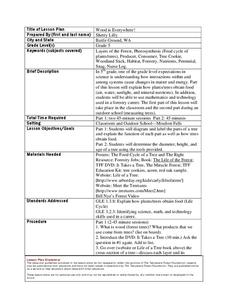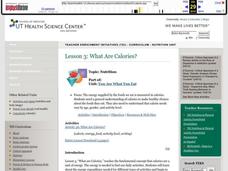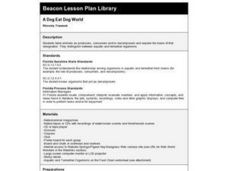Curated OER
Life Processes and Living Things-Humans and Other Animals
For this fill in the blank worksheet, learners respond to 20 short answer questions by identifying foods that contain large amounts of sugar, carbohydrate, and fruit acids and explaining their effects on the body.
Curated OER
Understanding Portion Sizes
Students analyze portion sizes in a healthy diet. In this portion sizes lesson, students complete a food group choices worksheet and identify the correct portion of food. Students work in groups to teach the unit to elementary students....
Curated OER
Grocery Shopping and Budgeting
Ninth graders establish a food budget based on individual needs and resources. They evaluate grocery stores and establish guidelines for purchasing specific foods.
Curated OER
Starvation in the Ghettos
Middle schoolers consider the lack of nutrition experienced in Holocaust ghettos. In this Holocaust lesson, students investigate the Nazi policy of starving people out of the ghettos through their food rationing program. Middle schoolers...
Curated OER
Math: Party Time!
Twelfth graders discover how to calculate the total costs for a party. They determine the unit prices of food and supplies, the quantities needed, and complete a chart displaying their findings. Students calculate the costs per serving...
Curated OER
Digestive System, a Kinesthetic Lesson
Students actively act out an aspect of the digestive tract on two parallel strips of tape on the floor 3-4 feet apart and width of classroom which represent the digestive tract.
Curated OER
Purchasing Power
Students participate in a lemonade sale and record their sales in a journal. In this fundraising lesson, students donate money they have raised from a lemonade sale and make a plan for how the money should be spent.
Curated OER
Edible Algae
Young scholars acquire an awareness and appreciation for the value of the organisms in the Protist Kingdom. They identify common Protists, name them and list some common products that contain marine algae.
Curated OER
What Do Soils Have to Do With Me?
In this identifying ways we use soils every day worksheet, students investigate their houses, home environment, clothing labels, and foods to see what was made from things grown in soils. Students write 5 short answers.
Curated OER
Understanding Our Planet's Food Web
Sixth graders, in groups, examine how humans have a tenuous position as part of an ecosystem.
Curated OER
What's on Your Plate?
Students analyze the calorie content of food. In this health science lesson, students discuss how excess calories affect our body. They write a healthy meal plan for their family.
Curated OER
What's My Nutrition Value?
Second graders, in groups, explore how to read labels on food packages. They learn the nutritional value of food.
Curated OER
Truth in packaging
In this packaging worksheet, students complete a chart where they weigh packages and compare it to the label on the package. Students complete the chart for 5 packages and answer 3 questions.
Curated OER
What's In Your Grocery Bag?
Young scholars explore the global implications of consumer decisions when purchasing groceries. They examine labels of food products and discuss the wording on the labels. They calculate food miles of how far each ingredient in foods...
Curated OER
It's Sugar Time!
Fifth graders review the Food Pyramid. They examine several breakfast cereal labels and determine how much sugar is in each. They discuss these amounts and whether or not they are surprised by the results. They discuss the amount of...
Curated OER
Lunchroom Trash
Students explore the amount of waste produced by humans. In this ecology lesson, students predict which lunch bag and its contents will produce the most waste. Leftover material is examined, amounts are recorded, and a bar graph is...
Curated OER
Wood is Everywhere!
Fifth graders diagram and label the parts of a tree. For this lesson on how trees obtain food, 5th graders diagram and label the parts of a tree, and determine the diameter, height, and age of a tree.
Curated OER
What Are Calories?
Students examine calories for the human body. In this calorie lesson, students explore the energy expenditures needed for different types of activities and how many calories are needed to support daily functions.
Curated OER
Where in the World?
Learners evaluate botany by participating in a class discussion. In this agriculture lesson, students identify the importance of knowing where food comes from and they discuss what their breakfast consisted of and where it came from....
Curated OER
St. Patrick's Day Snack
First graders design a green snack menu from all four food groups for St. Patrick's Day.
Curated OER
Science
Students read labels of candy bars. In this ingredients lesson plan, students examine a variety of candy bar labels to determine the contents. Students research to find additional information on each candy bar, then write an...
Curated OER
The Digestive System: An Overview
Students label main structures of the digestive system, describe each structure's function, and describe sequence of events involved in digestion.
Curated OER
Habitat Lap Sit
Students examine through role play interdependence of animal and man in their search for the proper arrangement of food, water, shelter and space in the same regions. Students then discuss necessary components of suitable habitat.
Curated OER
A Dog Eat Dog World
Fourth graders distinguish between acquatic and terrestrial organisms. They label animals as producers, consumers, and/or decomposers.
















